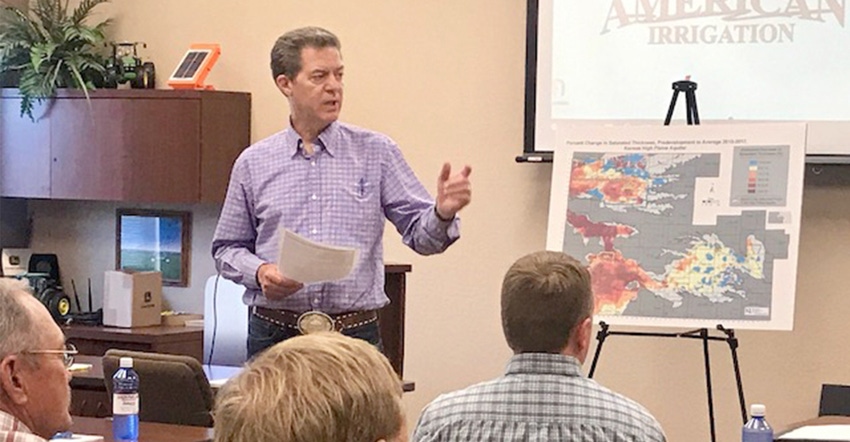
Precision agriculture isn’t just about autosteering, field maps and big data. On the ground, it just may be the best tool out there for saving the Ogallala Aquifer for a new generation or two.
Dwane Roth, owner of the Big D Water Technology Farm near Holcomb, told attendees at a July 18 Water Tour event in Garden City that he believes substantial reduction in water use can be achieved with little impact on production from farms and ranches by utilizing water technology innovations such as soil moisture probes and other precision tools.
Gov. Sam Brownback, Lt. Gov. Jeff Colyer and Kansas Geological Survey Senior Scientist and Geohydrology Section Chief Jim Butler spoke at two stops on the tour, one in at a feedyard in Hoxie and one at Garden City.
Data presented at the Hoxie meeting confirmed that the Local Enhanced Management Area known as the Sheridan 6 in northwest Kansas has dramatically reduced the decline of the aquifer, showing, in fact, that there was zero decline in 2015, the third year of the LEMA. Pumping has been reduced by more than 40% in the LEMA, even though the original goal was 20%.
At the Garden City stop, Roth gave a virtual tour of the Water Technology Farm, one of three in Kansas that were created last year to study the latest tools in water use reduction on a farm-scale level. A second water technology farm is on the Tom Willis farm near Garden City and the third is located at Larned.
Students and faculty from Northwest Technical College at Goodland attending the Water Tour and Ben Schears, president of the college, said water technology farms are a key element of the hands-on experience received by precision ag students at NT.
“The technology our students use and the skills they learn make them incredibly valuable to the agricultural workforce throughout the state of Kansas,” Schears said.
Farmers in Finny and Kearny counties have developed a proposal to create the KFL LEMA for a 200-square-mile area. Leaders believe they can double the life of the Ogallala Aquifer in that area with a 15% reduction in water use.
 PROJECTED EFFECT: This chart from Kansas Geological Survey shows the water use and annual decline of the Ogallala Aquifer in the proposed KFL LEMA area in Finney and Kearny counties. The brown dashed line shows the average use, about 115,000 acre-feet per year, and the annual decline, about 3.43 feet. The projection, the red dashed line, shows that a reduction to 83,000 acre-feet would stabilize the aquifer.
PROJECTED EFFECT: This chart from Kansas Geological Survey shows the water use and annual decline of the Ogallala Aquifer in the proposed KFL LEMA area in Finney and Kearny counties. The brown dashed line shows the average use, about 115,000 acre-feet per year, and the annual decline, about 3.43 feet. The projection, the red dashed line, shows that a reduction to 83,000 acre-feet would stabilize the aquifer.

Data presented by KGS shows the reduction in pumping would have a large impact on the rate of decline of the aquifer and would also slow the rate of increase in groundwater salinity.
Roth said that cutting pumping will save money as well as water. He said the information from moisture probes has him on track to save about half of normal water use this season.
Troy Dumler, manager of the Garden City Co., said a 15% reduction in water use in his area could save about $1,350 per pivot in energy costs.
“Drops in static water levels and declines in pumping capacity have the irrigators within the company looking for alternatives that balance both short-term and long-term economic needs,” Dumler said.
Data from KGS shows that the average level of pumping in the proposed LEMA from 2005 through 2015 has been about 115,000 acre-feet per year and the aquifer has been declining at a rate of 3.43 feet per year.
During the severe drought of 2012, area irrigators pumped about 150,000 acre-feet of water, and the aquifer dropped almost 7 feet. In 2015, a considerably wetter year, pumping was about 95,000 acre-feet, and the aquifer dropped only about a foot.
Projections from KGS show that a 28% reduction in pumping, to about 83,000 acre-feet per year, would make the aquifer in that region stable with no decline in saturated thickness.
The water technology farms now in operation are all studying some applications of DragonLine mobile drip irrigation and utilizing soil moisture probes to guide pivot use. Ten more water technology farms are planned throughout western Kansas to test more technologies at farm scale.
In addition to the LEMAs, Kansas has also allowed any water right owner or group of owners to develop a management plan to reduce water withdrawals by participating in a Water Conservation Area, which allows great flexibility in use. Kansas currently has six active WCAs, and more are in the process of being approved.
The additional emphasis on efforts to help slow the decline of the Ogallala is part of the governor’s initiative known as the 50-Year Vision for the Future of Water in Kansas.
About the Author(s)
You May Also Like




